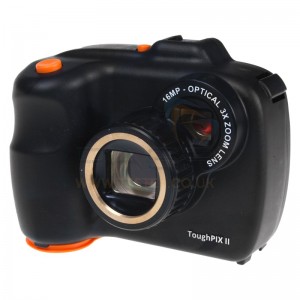Buying an Ex digital camera often costs many times that of its non-Ex equivalent. CorDEX has published a checklist to help potential users work their way through the maze of features. Ranging from affordable point-and-shoot models to high end compact digital SLRs, intrinsically safe refers to a method of protection that prevents ignition by spark of thermal means.
Professionals users have different needs. A quality control officer may be interested in the colour of paint being used, so clear, repeatable, high quality imagery is essential. A maintenance crew member may need to document wide area and close in shots in order to document before and after work, so an adaptable lens with both optical and digital zoom is imperative.
A safety inspector may need to take shots of Ex-rating plates of motors, valves or any number of process equipment located within the hazardous area to ensure compliance and in this case, an optical macro lens is not only essential; it is vital to the safety documentation process.
10-point checklist
The ten most important points when considering an Ex digital camera follow.
1) Buy a digital camera with the greatest number of pixels/best image quality that your budget can afford. You can always drop pixels if you don’t need them, but you cannot create them if they do not exist. With digital zoom to back up optical zoom solution to enhance fine detail that may have been missed in the field.
2) Consider a digital camera that is rugged enough to do the job you need it to do, each day, every day. Work in a tough environment means equipment gets bumped and dropped. A camera needs to be tough too, while some Intrinsically Safe digital cameras are similar to smartphones with large colour displays that are easily damaged but very difficult, if not impossible to replace. A camera with an armoured screen can withstand day-to-day impacts and abuse without damage.
3) Documenting to a database reporting package facilitates organisation and analysis of findings. A comprehensive report database package helps create professional reports and ensures data is collated and stored. CorDEX CONNECT is simple to use but allows for growing report and database requirements. Images are stored automatically and may be annotated with comments, boxed, layered, cropped and resized.
4) A removable, rechargeable battery provides the best return on investment from a Ex digital camera. Fixed internal batteries cannot be replaced when they age, while a rechargeable battery can be removed for charging and another fitted to continue work without interruption.
5) Make sure your Ex digital camera id from a manufacturer with a strong track record and world-wide support.
6) Interchangeable lenses such as a macro lens allows a camera to be adapted to take close up shots that even an optical and high resolution digital zoom cannot resolve. If the work involves taking pictures of Ex rating plates for documentation purposes, a macro lens effectively enlarges a close-up target. The full CCD sensor array is used to capture the image, meaning the digital camera can take clear, high resolution shots at a range of 50mm or less.
7) A picture is worth a thousand words - but only when in focus. Where there is a need to take images of rating plates or machinery detail at distances less than 150mm, cameras equipped with macro mode can achieve this. However, with automatic focussing, the camera may ignore the wanted object to focus on other areas in its field of view instead. Achieving a sharp focus with macro mode needs an LCD display, good light conditions and patience.
8) Choose a digital camera that operates in the environment you work in. Will you be using your camera in winter/cold environments? Will you be wearing PPE or gloves? A digital camera designed for this environment should be simple to operate while wearing specialist protective clothing such as bulky gloves, even those made from fire retardant (FR) material. A digital camera’s power (On/Off) and shutter buttons should be sufficiently spaced so that they do not interfere with one another and be prominent enough to be easy to locate and operate even when wearing heavy gloves.
9) Low lighting pictures means a flash is essential. An on-board, high intensity, flash is essential. A strobe type flash will not only illuminate close up targets, but also wide area shots required for plant inspection and documentation.
10) Do not trust putting your camera in your pocket where it can fall out. Select a camera with wrist and neck straps, making it easy to use, less restrictive on the user and less tiring but most important of all, safer for personnel.
For further information, please visit PASS Ltd’s specialist Intrinsically Safe Equipment web page.



